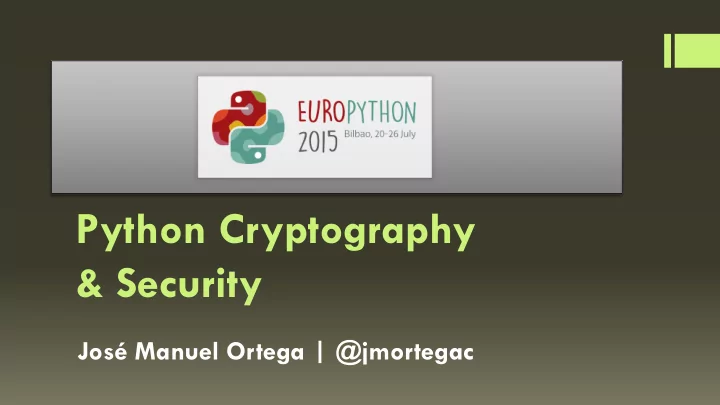

Python Cryptography & Security José Manuel Ortega | @jmortegac
https://speakerdeck.com/jmortega
Security Conferences
INDEX 1 Introduction to cryptography 2 PyCrypto and other libraries 3 Django Security 4 OWASP & Best Practices 5 Steganography
Introduction to cryptography Key terms Caesar Chiper Hash functions(MD5,SHA) Symetric Encryption(AES) Asimetric Encription(RSA) PBKDF2-Key derivation function
Key : The piece of information that Key terms allows you to either encrypt or decrypt your data. Plaintext : The information that you want to keep hidden, in its unencrypted form. The plaintext can be any data at all: a picture, a spreadsheet, or even a whole hard disk Ciphertext : The information in encrypted form Cipher : The algorithm that converts plaintext to ciphertext and vice-versa
Key terms Salt – randomizes the hash of the key; advanced prevents rainbow table attacks against the key IV (initialization vector) – randomizes the encrypted message; prevents rainbow table attacks against the message Derived Key – lengthens and strengthens the key via hashing; used instead of the original key; slows down brute-force attacks against the key
Caesar Chiper >>Ymnx%nx%r~%xjhwjy%rjxxflj3
Hash functions Calculate the checksum of some data File integrity checking Generate passwords Digital signatures and authentication MD5 SHA-2(256 and 512 bits) SHA-3
Hash functions
https://docs.python.org/2/library/hashlib.html Hashlib functions One-way cryptographic hashing >>03187564433616a654efef944871f1e4 >>bd576c4231b95dd439abd486be45e23d47a2cbb74b5348b3b113cef47463e15a >>d47b290aa260af8871294e1ad6b473bd48b587593f8dea7b1b5d9271df12ee081 85a13217ae88e95d9bd425f3ada0593f1671004a2b32380039d3c88f685614c >>8fadab23df7c580915deba5c6f0eb75bd32181f55c547a2b3999db055398095c33f 10b75c823a288e86636797f71b458
MD5 hash function Checking file integrity >>d41d8cd98f00b204e9800998ecf8427e
Hash passwords in DB Websites store hash of a password h ashlib.sha256(‘password'). hexdigest() >>'5e884898da28047151d0e56f8dc6292773603d0d6aabbdd62a11ef721d1542d8'
Hash passwords in DB
Hash identifier https://code.google.com/p/hash-identifier For checking the type of Hash
Symetric encryption AES Shared key for encrypt and decrypt key size (bytes in cipher ASCII) AES-128 128 bits (16 bytes) AES-192 192 bits (24 bytes) AES-256 256 bits (32 bytes)
Asymetric encryption RSA 2 keys(public key and secret key) Public key(Pk) for encrypt Secret key(Sk) for decrypt Public key is derived from secret key
Asymetric encryption
Encryption vs Signing Encryption When encrypting, you use their public key to write message and they use their private key to read it. Signing When signing, you use your private key to write message's signature, and they use your public key to check if it's really yours.
Digital signature Signing a message Only the owner of Pk/Sk pair should be able to sign the message
PyCrypto https://pypi.python.org/pypi/pycrypto Supports Hash operations Block cipher AES,RSA Sign/verify documents >> pip install pycrypto
PyCrypto Hash functions from Crypto.Hash import SHA256 SHA256.new (‘password'). hexdigest() >>'5e884898da28047151d0e56f8dc6292773603d0d6aabbdd62a11ef721d1542d8' from Crypto.Hash import SHA512 SHA512.new(‘password'). hexdigest() >>'b109f3bbbc244eb82441917ed06d618b9008dd09b3befd1b5e07394c706a8bb98 0b1d7785e5976ec049b46df5f1326af5a2ea6d103fd07c95385ffab0cacbc86'
PyCrypto AES >>> d1a2ea7f9661fae8b46b3904b0193ab81516653f73216dfeb5f51afde3d405b2 a secret message
Generati erating ng key fro rom m passwor word PyCrypto PBKDF import Crypto.Random from Crypto.Protocol.KDF import PBKDF2 A salt is a random sequence added to the password string password = 'europython' before using the hash function. The salt is used in order to iterations = 5000 prevent dictionary attacks and rainbow tables attacks. key = '' salt = Crypto.Random.new().read(32) key = PBKDF2(password, salt, dkLen=32, count=iterations) print 'Random salt (in hex):' print salt.encode('hex') print 'PBKDF2-derived key (in hex) of password after %d iterations: ' % iterations print key.encode('hex') Random salt (in hex): 724138b9d987a04bf05d285db678824f9b7e2b1232229711c2e0e2e556a0c19a PBKDF2-derived key (in hex) of password after 5000 iterations: d725de7de88e27d16c9c4f224d4c87159735708419d1c949074962b48ce26900
Generate an RSA secret and public key pair PyCrypto RSA from Crypto.PublicKey import RSA def generate_RSA (bits = 1024): #Generate an RSA keypair with an exponent of 65537 in PEM format #param: bits The key length in bits #Return secret key and public key new_key = RSA . generate(bits, e = 65537) public_key = new_key . publickey() . exportKey("PEM") secret_key = new_key . exportKey("PEM") return secret_key, public_key
Generate an RSA secret and public key pair PyCrypto RSA -----BEGIN PUBLIC KEY----- MIGfMA0GCSqGSIb3DQEBAQUAA4GNADCBiQKBgQCYS9ITbjKu5i9i36FgzKg/HO3o 6CKGJ1c5E57qVlmYF6L1BcgH+eE+XiwJ6fWyShaVnZDuvUapWgQeOGZ60QBJ/vpu DdwqsuGoTeJNqaRT9ButJa+o+0tchRKBcM6zKUXYWc7kdAlxEpO2OXZEqxD7bd1O oxv7mEjqBpVXgNEVrwIDAQAB -----END PUBLIC KEY----- -----BEGIN RSA PRIVATE KEY----- MIICXAIBAAKBgQCYS9ITbjKu5i9i36FgzKg/HO3o6CKGJ1c5E57qVlmYF6L1BcgH +eE+XiwJ6fWyShaVnZDuvUapWgQeOGZ60QBJ/vpuDdwqsuGoTeJNqaRT9ButJa+o +0tchRKBcM6zKUXYWc7kdAlxEpO2OXZEqxD7bd1Ooxv7mEjqBpVXgNEVrwIDAQAB AoGAc0qqzTTWP5tYciRTmeE02RqAbJoXULHFkRruaf5WsxHptk3bIVakkr9d3V91 NbRqpnby+hjlvly701jlE8LW0QIccII9oWyV6kMSTEJMth9RlXpCbQY285pwg+bF zyEhQJmjMj1hMDJLQ8dXLCeqXZ37etYGHTT2XQ+q5TOW4YkCQQC5WDQHBhYa/Mzt UlXemLxv1ERaxt8zmXSX0bKjIkaYMv1SF3FskiN9Rm/zXvil3HuiySBq9g6/fPbN T1+dtiZTAkEA0lpsRUqamIbii18aBBQGs/FbrUa71ahpoU7+8wXMxNYQBfVGvlzs J+tKxSecMO196Hl4l5I14ASEs+4wKK5vtQJARe4gmzHRr1cIntY87eKk3nCxZaq5 Vkek9Q86nlB1YEGE0K9lrTgqSb8EyEdh+3qH73CBWboC8H7ew7IZ+nBaXwJBAJEO K8Vomcz+jvB/B0iyqqChmo+VzGecuCK1f9gEMt21o90H893H5E3u0mO8WdffnciX I1KaT66ITx5o7SrQh1UCQGqP8B9bpzXjxMuLUJuL1DoRP4QBGHoXokdu8gKAlPzp ZK8BKRSPRobwlNFlXWfXLAWIFwXIeqOblI20U/oNwNE= -----END RSA PRIVATE KEY-----
PyCrypto RSA from Crypto.PublicKey import RSA from Crypto.PublicKey import RSA from Crypto.Cipher import PKCS1_OAEP from Crypto.Cipher import PKCS1_OAEP from base64 import b64decode def encrypt_RSA (public_key, message): def decrypt_RSA (secret_key, message): key = (public_key, "r") . read() key = (secret_key, "r") . read() rsakey = RSA . importKey(key) rsakey = RSA . importKey(key) rsakey = PKCS1_OAEP . new(rsakey) rsakey = PKCS1_OAEP . new(rsakey) encrypted = rsakey.encrypt(message) decrypted = return encrypted . encode('base64') rsakey.decrypt(b64decode(message)) return decrypted
PyCrypto Sign/verify from Crypto.PublicKey import RSA from Crypto.PublicKey import RSA from Crypto.Signature import PKCS1_v1_5 from Crypto.Signature import PKCS1_v1_5 from Crypto.Hash import SHA256 from Crypto.Hash import SHA256 from base64 import b64decode from base64 import b64encode, b64decode def verify_sign (public_key, signature, data): ‘ def sign_data (secret_key, data): #Verifies with a public key that the data was signed by their key = (secret_key, "r") . read() #private key rsakey = RSA . importKey(key) pub_key = (public_key, "r") . read() rsakey = RSA . importKey(pub_key) signer = PKCS1_v1_5 . new(rsakey) signer = PKCS1_v1_5 . new(rsakey) digest = SHA256 . new() digest = SHA256 . new() digest . update(b64decode(data)) digest . update(b64decode(data)) if signer . verify(digest, b64decode(signature)): sign = signer . sign(digest) return True return b64encode(sign) return False
PyCrypto RSA/Sign/verify True True True public_key <_RSAobj @0x2b56648 n(1024),e> encrypted data ('I\xe6\xff\\ M$\x12\xbb\x95\xee\x02\xcf\x82Im\tf+\x1f\xaeU\xbdv` ^\x94\xfa\xe6_\x8b\xed\x8d\xa3\xab\xfc \xae\x17\x07=|\x18\xca\x18j\xc5\x1d\x01\xad`\xd6W E\xfbU\xd1\x12\x0c- \xb6\x9c\xc4\x07\xaa\x93<\xb5zw&\x98\xa2\xdc\x8e\ x9e- \x06gQ\xcf\xfa\xc8r/\xd5\x98|\xd5\xcdg\xb2\xda\xcd: d\xaf\xde\xe2\xcd\xcd\xf5{p`\x07\xbb~\x1b\xa4hHJ#c\ tE6\xfa\xc3\x87\x8d\xf2O8,\xe2W',) signature (445755122549853282247622461459180943435051515 5918916324891286777775175591376873419505852842 3900156177220742858645089371096255086061177099 8101038368420840785203067622854793789417670298 3088451295738677105320376959152029164761636442 8930467543317371804318093617486393498897888949 152557196686676342045445446511829L,) decrypt_data EUROPHYTON2015 True
Best practices Avoid hashing methods like MD5 or SHA-1,use at least SHA-2 or SHA-3 Key Stretching for strong passwords Preventing Brute-force or dictionary attacks for i in xrange(iterations): m = hashlib.sha512() m.update(key + password + salt) key = m.digest()
https: tps:// //cryptogr cryptograp aphy. hy.io Cryptography $ pip install cryptography Support for Python 3 Support for modern algorithms such as AESGCM and HKDF Improved debugability and testability Secure API design
https: tps:// //cryptogr cryptograp aphy. hy.io Cryptography
https: tps:// //cryptogr cryptograp aphy. hy.io Cryptography
Recommend
More recommend